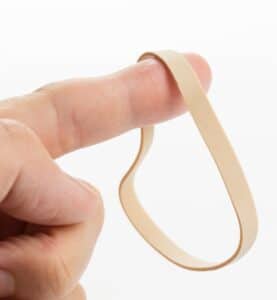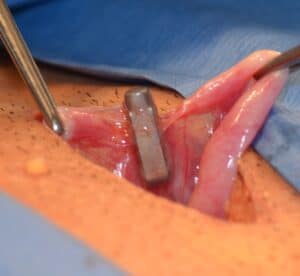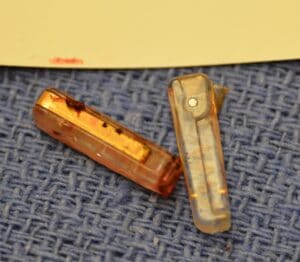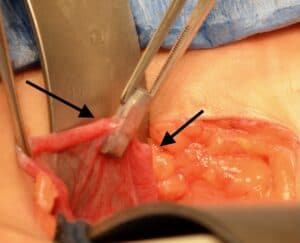Tubal clips tubal ligation is the best type of tubal ligation to reverse! If you are regretting your decision to get tubal clips and want more children you have two options to have another child: in-vitro fertilization (IVF) or having the clips removed and the tubal segments surgically rejoined (tubal reversal surgery).
IVF will give you a 40% chance of getting pregnant. Reversing tubal clips can provide an 80% chance of pregnancy success! Why would you not want to consider tubal reversal surgery?
Surgically reversing tubal clips is half the cost and twice as successful as IVF.
Tubal clip tubal ligation is one of THE BEST tubal ligations to reverse. Why?
Tubal clips only damage a small portion of the fallopian tube. After reversing tubal clips, the tubes are usually long and healthy. Reversing tubal clips provides the best chance of pregnancy success. If you are having symptoms from tubal clips then removing the tubal clips can also help.
Tubal ligation procedures can be performed in many ways. One unique tubal ligation method is to apply specially designed clips across the fallopian tubes. These clips cause permanent blockage of the fallopian tube.
Tubal clips are usually placed during a laparoscopic procedure (tiny camera placed through a small incision made in the belly button). Tubal clip ligation is often performed several weeks or months after having a baby but some doctors will place the clips at the time of a cesarean delivery or immediately after a vaginal birth.
Reversal of tubal clips can provide a patient with an excellent chance at becoming pregnant. If you are one of those rare people who are having symptoms from the clips then removing the tubal clips will often help.
Two types of clips used for tubal ligation
There are two common types of tubal clips: Hulka clips and Filshie clips.
The Hulka clip is made of plastic with a gold spring lock.
The Filshie clip is made of titanium with a soft, inner silastic lining. Although designed differently both cause types of clips cause permanent tubal blockage and prevent you from becoming pregnant.
Both types of clips are placed across the narrowest portion of each fallopian tube. The clips cause the tube to heal closed and be permanently blocked.
How do tubal clips prevent pregnancy? You will be surprised
Many people think they know how tubal clips actually work…but many are surprised to find out how they actually prevent you from becoming pregnant.
Most people think placing the clip is like putting a clip on a bag of potatoes chips. If you want to close the bag…place a clip on it. If you want to open the bag then just remove the clip. Unfortunately this is not how FALLOPIAN TUBE CLIPS work!
When the clips are placed on the fallopian tubes the clips cause tremendous pressure on the tissue of the tube where the clips are placed. The clips squeeze and lock tightly across the tube. The clips cause the tubal tissue immediately underneath the clips to die by depriving the tissue of blood and oxygen. This dead tissue is then absorbed by the body.
Imagine putting a tight, tight rubber band on your finger…like you did when you were a kid and your finger turned purple.
 Now imagine leaving that rubber band on your finger for a month…without taking it off. You would eventually lose your finger. This is how clips work….only the entire tube is not lost…only the very small area of tissue underneath the clip.
Now imagine leaving that rubber band on your finger for a month…without taking it off. You would eventually lose your finger. This is how clips work….only the entire tube is not lost…only the very small area of tissue underneath the clip.
The difference between a finger and a fallopian tube is that the finger has only one source of blood supply coming from the hand…the tube has a blood supply coming from the uterus and the ovary….so the entire tube is not lost after tubal clips are placed.
The small area of tissue underneath the clip will be absorbed (dissolved by the body) and the tubal edges next to the clips will heal closed and separate. This is how tubal clips cause permanent blockage.
The tubal clips will not serve any purpose after the tubal edges have healed closed. The tubal clips have done their job within the first week of being placed.
Just like in our analogy above…if you remove the tight rubber band from around your finger a month after you placed it…the damage is already done to your finger.
Removing the rubber band does not do anything…the damage has already been done.
What types of clips do you have?
There are only two types of clips: Filshie (titanium) and Hulka (plastic) clips. To some extent it does not matter which type of clip you have. They are both good at preventing pregnancy and they are both good for reversing. Both tubal clips can cause symptoms.

This Filshie clip has severed the Fallopian tube. Simply removing the clip will not allow you to become pregnant
Filshie clips are more common than Hulka clips. Hulka clips…for reasons unknown to us… have fallen out of favor over the last two decades. Flishie clips are commonly used in Canada and the United States. Tubal clips are almost never used in Mexico, Central America, or the Caribbean.
Clips are usually placed several weeks after giving birth during a laparoscopic procedure. Some doctors will place clips at the time of C-section or after a vaginal birth… especially if they think you will regret your decision in the future.
The best way to know what type of clips you have is to request a copy of your tubal ligation operative report. This report will usually tell you the types of clips that were used. A Personal Choice Tubal Reversal Center specializes in tubal ligation reversal for pregnancy and for treatment of tubal ligation symptoms. If you are considering clip removal and want us to evaluate your records you can send your tubal ligation operative report to us for a free review.
Want to know how to get your records? Visit: Tubal reversal: Getting started
Want to know how to send us your records? Visit: Contact Us: Send us your medical records
You could also have your doctor order a pelvic x-ray because tubal clips will easily show up on x-ray. The Filshie clips are the easiest to see…but the Hulka clips can also be seen because they have a gold metal band on the outside of the clip. Both clips have very unique appearances on x-ray. If you have plastic fallopian tube rings…these do not show up on an x-ray.
Can tubal clips fall off?
Fallopian tube clips can definitely fall off and they can definitely migrate (or move around inside the body). In our experience, Filshie clips are notorious for coming off the fallopian tubes…the Hulka clips almost never fall off the tubes. Why?

Hulka clips
The Hulka clips are designed with jagged alligator teeth that both compress and bite into the tissue. These clips usually lock in place. Reactive fibrosis, or scar tissue, forms and is more commonly seen with Hulka clips for reasons unclear to us. This scar tissues helps bind…or glue.. the Hulka clips in place. We have never seen a Hulka clip fall off the tube or migrate at the time of reversal surgery.
Filshie clips can fall off the tubes commonly. We estimate about 10% of patients have one or both clips fallen off the tube at the time of reversal surgery. Filshie clips do don’t seem to cause the same time of fibrosis scar tissue as the Hulka clips. There seems to be less scar tissue to hold the clips in place. In some sense they work so well they tend to fall off the tubes more than the Hulka clips. But dont worry…you won’t get pregnant because when these clips fall off the tubes usually are damaged and heal closed in the area where the clips were placed.
We have also observed Filshie clips seem to fall off and migrate more when they are placed at the time of c-section.
Can tubal clips migrate?
Tubal clips can migrate. The Filshie tubal clips are notorious for falling off the fallopian tubes and migrating. The Hulka clips usually stay on the fallopian tubes. It is extremely rare for a Hulka clip to migrate in the abdomen.
What is clip migration? Tubal clip migration is when a clip comes off the fallopian tube and moves to a different area in the pelvis or abdomen.
Many women will have an x-ray and be told there clips have fallen off their tubes. These women will usually have two questions: 1) are they going to get pregnant and 2) will these migrating clips cause a problem?
Pregnancy. If the clips fall off then you will not get pregnant. The tubes are permanently closed from the pressure necrosis caused by the clips. Usually the clips fall off after the tissue has necrosed and been absorbed.
Problem(s). Migrating clips do not TYPICALLY cause problems. In fact most women never know there clips are off until the get an x-ray for some other reason. The most common story we hear is someone went to a chiropractor, had an x-ray, and it was observed their clips were not in the correct location.
So in our experience, most women will not have a problem from migrated clips.

Black arrows show the closed tubal ends after the tubal clip caused permeant closure from compression injury
We do A LOT of tubal reversal surgery…this means we see A LOT of different things. In our experience, some women will have complications from tubal clips or from migrating clips. In our experience we have seen clips causing problems when endometriosis forms around the tubal clips, when the clips are incorrectly applied or scar to the round ligament (structure near tubes that supports the uterus), clips that migrate and become embedded in the wall of the sigmoid colon, and clips that are attached to the posterior (back wall) of the abdomen or pelvis.
Clips that usually fall off the tubes don’t usually cause problems. Most of them fall…or migrate… harmlessly in front or in back of the uterus. If they are not in the pelvis…they are often safely picked up by the omental fat.
Filshie clips commonly fall off the tubes. In our patients, we observe this approximately 10% of the time. We have never seen a Hulka clip fall off or migrate.
What happens if you can’t find a clip?
We know the common hiding spots when clips migrate but we always advise our patients we cannot guarantee with 100% certainty that we can find both …. or all tubal clips. If a patient wants to become pregnant then finding the tubal clip is not critical. The tubes and uterus dont move. We can always find and repair the tubes.
Removing Tubal Clips
Many people mistakenly believe a tubal clip ligation can be reversed simply by removing the clips. Unfortunately reversal of tubal clips is not that simple.
 The tubal clip must be surgically removed from the fallopian tube. The closed edges of the tube on each side of the clip must be surgically reopened, and the tubal edges rejoined though microsurgical tubal reversal.
The tubal clip must be surgically removed from the fallopian tube. The closed edges of the tube on each side of the clip must be surgically reopened, and the tubal edges rejoined though microsurgical tubal reversal.
Because the clips are very narrow they damage the least amount of fallopian tube compared with other types of tubal ligation procedures. The chance of pregnancy after reversal of tubal clips at our center is approximately 78%.
Fallopian tube clips are the best tubal ligation method to reverse…if you have questions about tubal clip removal/reversal then visit the website of A Personal Choice for more information.
Want to know if you are a candidate for reversal surgery?
Although tubal clip tubal ligation is one of the best types of tubal ligations to reverse, the reality is that there are many other types of tubal ligation procedures. Most tubal ligations are not done with tubal clips. The most common tubal ligation procedure is tying and cutting or burning.
Tying, cutting, and burning all sound bad but the majority of these tubal ligations can be reversed and provide you with a good chance of pregnancy success.
If you want to know if you are a candidate for reversal surgery then you should watch the video below.
After watching the video you should send your tubal ligation operative records to A Personal Choice for a free review. They will look at your records, free of charge, and get back to you with a recommendation within 24 to 48 hours.
Successful tubal reversal surgery
Tubal reversal surgery can be more successful than IVF.
Reversal allows you to treat the guilt and regret you may have about tubal ligation. Reversal allows you the chance of become pregnant each month and more than once. Reversal allows you to have more than one child.
You should do like many other women and travel to Raleigh North Carolina to have your reversal surgery with America’s best tubal reversal surgeons at A Personal Choice Reversal Center.









